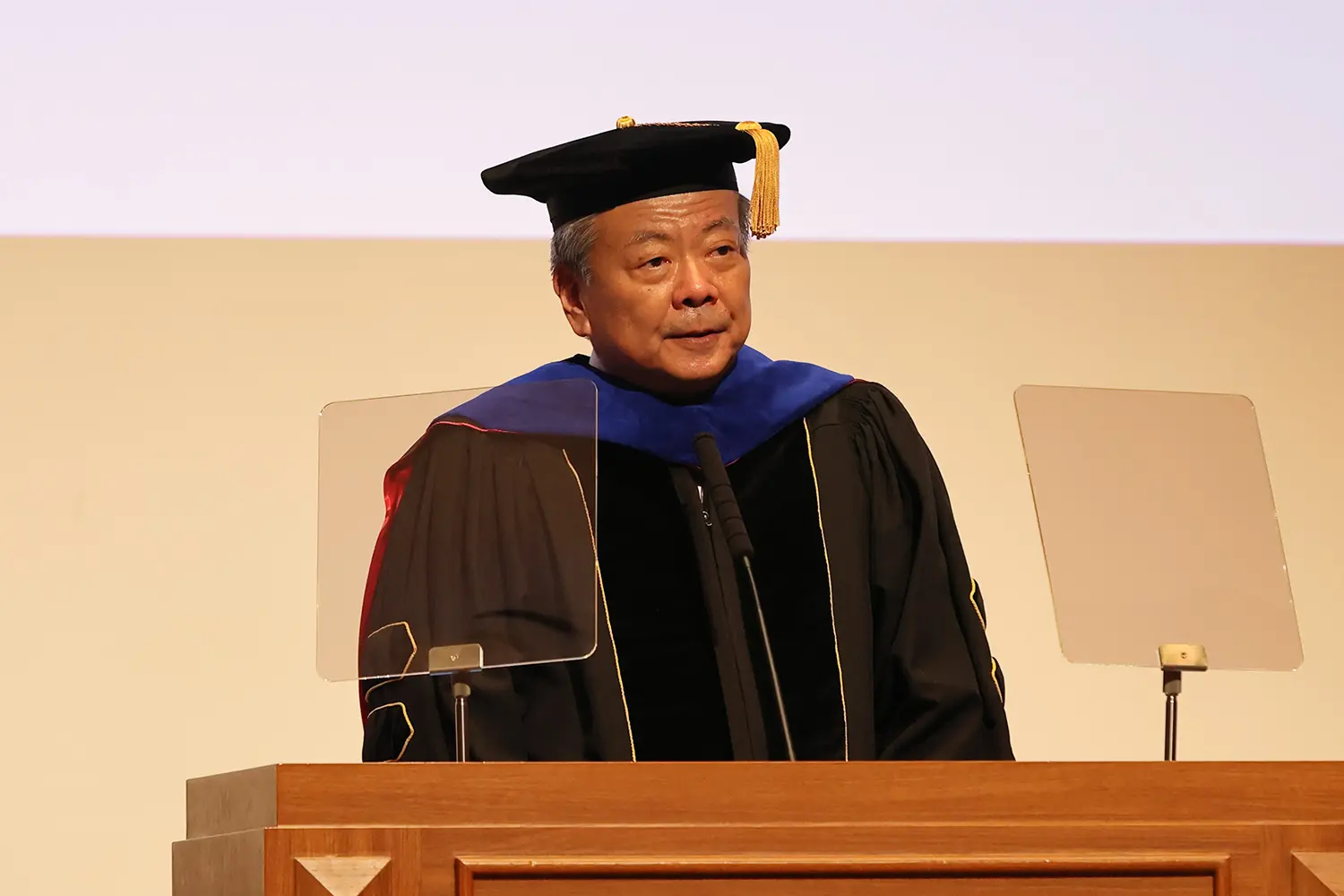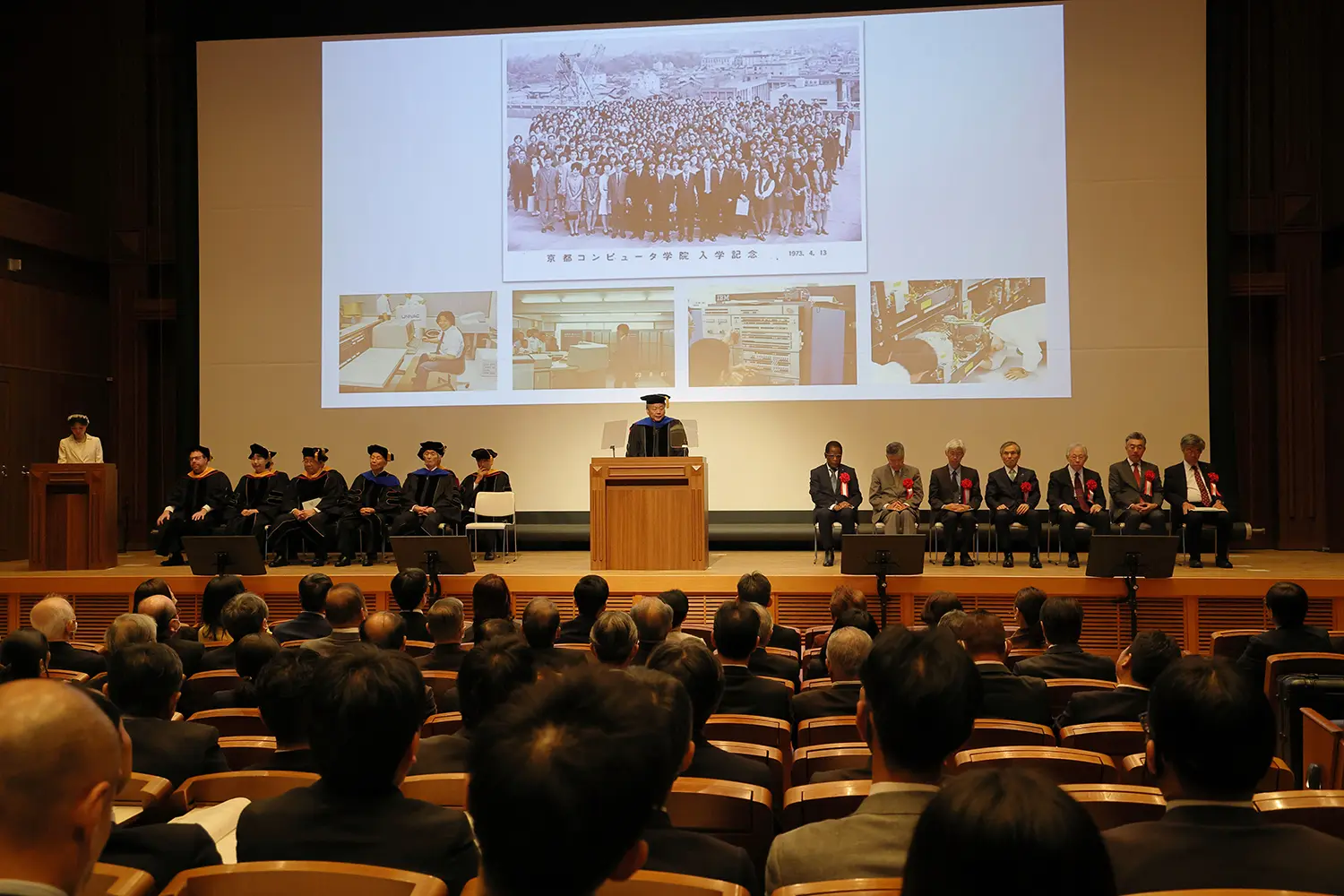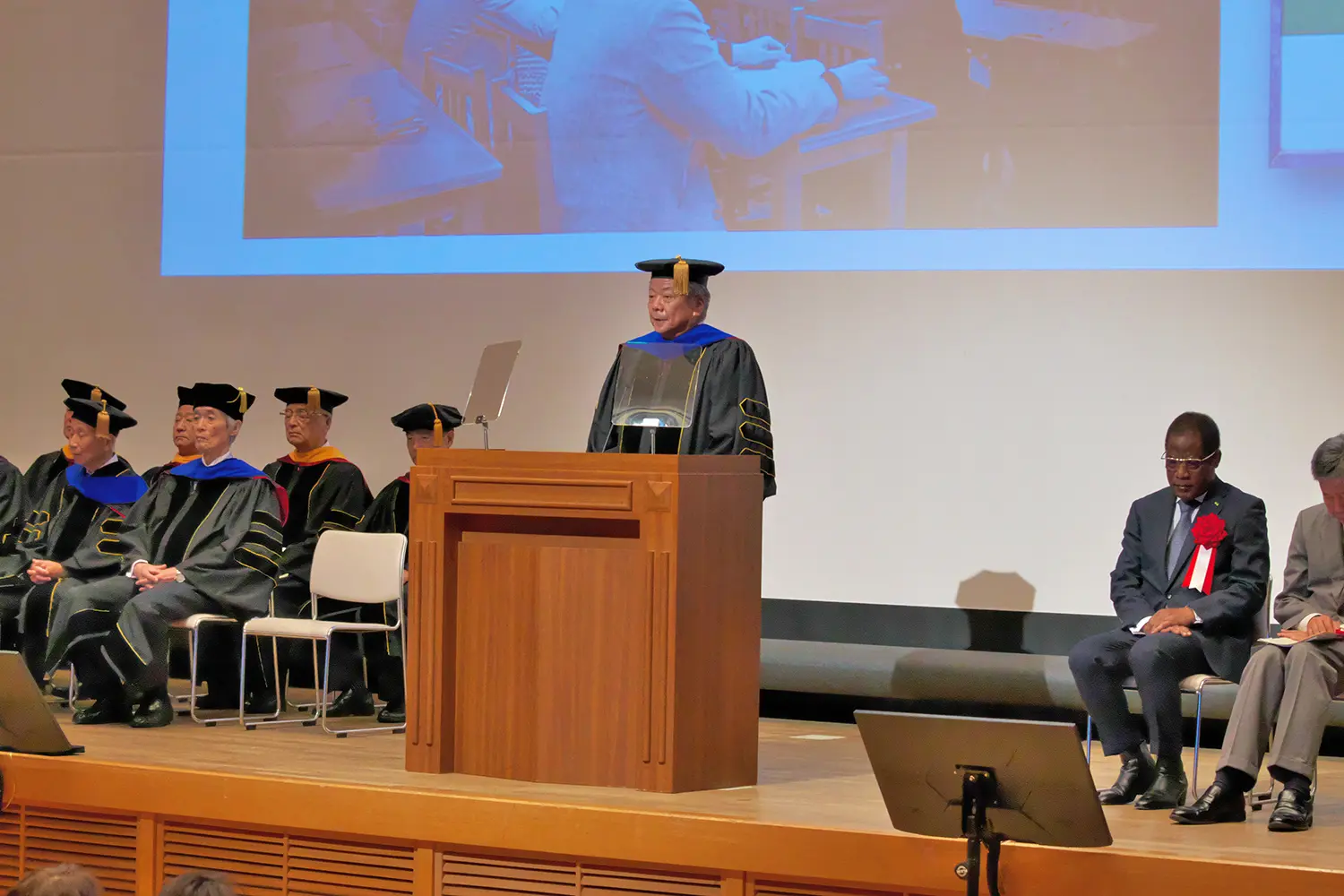理事長・総長式辞
Address by Chairman/Rector
READ ENGLISH
京都コンピュータ学院・京都情報大学院大学・京都自動車専門学校
理事長・総長 長谷川 亘
京都コンピュータ学院創立60周年・京都情報大学院大学創立20周年記念式典にあたり,関係各国の大使閣下ならびに大使館関係の皆さま,京都府・京都市関係の皆さま,国内外の大学をはじめとする教育機関,各法人や企業,そして各界の多くの皆さまにご来臨賜りましたことを,心より厚く御礼申しあげます。
京都コンピュータ学院は本年,創立60周年を,また,京都情報大学院大学は,2003年の開学宣言と認可決定以来,20年となり,ともに佳節を迎えました。
ご多用の中,多数の御来賓の皆さま,卒業生・修了生・校友の皆さま,在学生の皆さま,ライブでこのストリーミング配信をご覧になっているインターネット上の皆々さま,お集まりいただきまして,大変ありがたく存じます。本日,記念式典を挙行できますことは,私ども教職員にとりまして,大きな喜びであり,感謝の念に堪えません。
本学は現在,京都コンピュータ学院洛北校,鴨川校,京都駅前校,京都日本語研修センター,京都自動車専門学校,京都情報大学院大学の京都本校,札幌サテライト,東京サテライトの各校,そして教育活動をサポートする株式会社KCGキャリア等により,一つのグループを構成しておりKCGグループと自称しております。本日は,歴史を少し振り返りながら,現在のデジタル社会における本学の取り組みについてお話しさせていただきます。
京都コンピュータ学院の原点は,京都大学の卒業生であり,大学院生であった初代学院長・長谷川繁雄と現学院長・長谷川靖子が始めた小さな私塾にあります。自宅で始めた中学生・高校生対象の小さな塾でしたが,1963年(昭和38年)に,その教室で,京都大学の若手研究者を中心とした「FORTRAN研究会」が始まりました。コンピュータがまだごく一部の研究者だけのものだった時代にあって,日を重ねるにつれ,その研究会は近畿圏の他大学の研究者や企業関係者にも知られるところとなります。
その後,1969年(昭和44年)に「京都コンピュータ学院」という校名を掲げて,高等学校卒業者を対象とする全日制課程が開設されました。その当時,学院創立者 長谷川繁雄初代学院長は,「ソフトウェアとは,ものの考え方のことであって,哲学の一種であり,これは人類史を変革する」という言葉を残しております。創立以来,本学は,「時代を担う創造性豊かな情報処理技術者の育成」を使命としまして,次の5カ条を教育理念としてまいりました。即ち,「コンピュータ技術の学問的性格を重視し理論をおろそかにしない本格教育」,「コンピュータ技術の進歩発展に対応する教育」,「コンピュータ技術における創造的能力の養成」,「情報化社会における複眼視的思考力の養成」,そして,「知性・感性ともにすぐれた人格の育成」であります。この教育理念は,時を経ても変わることなく本学の根幹であり,「KCGのDNA」として受け継がれています。
1972年(昭和47年),本学は,当時の最新鋭汎用コンピュータ TOSBAC-3400を木造二階建ての校舎内に導入・設置しました。このことは「たとえ校舎はバラックであっても,学生には時代の最先端の教育環境を与えよう」という教育哲学の現れでした。その後,各校舎には,大型コンピュータが次々と設置されていったのですが,70年代から80年代にかけて,いくつもの汎用大型コンピュータが専門学校の学生の実習用としてすべて開放されるというのは異例のことでしたので,それは全国の国公私立大学の羨望の的となりました。他大学の多くでは,高価なコンピュータは,大学院生や研究職のためのものであって,学部学生が使用できるという事例は極めて少なかったのです。それらのコンピュータは現在もこの京都駅前校に保存・展示されております。「国内屈指の貴重な機器を多数保存している」との理由により,2009年(平成21年)には,一般社団法人情報処理学会様から「分散コンピュータ博物館」の全国第一号認定を受けております。また,所蔵するコンピュータのうち7機種が,現在までに「情報処理技術遺産」として認定されております。
さて,本学はパソコン時代到来に先立ち,1983年(昭和58年)には当時の3000名余の学生全員に一人一台のパソコンを無料で貸与するという教育方針を立てて実施いたしました。これは世界的にも初めての取り組みでした。他の国においては,アメリカのカーネギーメロン大学が,本学に半年遅れて同様の施策を取りましたが,カーネギーメロン大学もコンピュータ学科の学生だけでした。学生全員に一人一台のパソコン貸与というのは本学とカーネギーメロン大学のほかは寡聞にして知るところではありません。
そして米国国防総省の高等研究計画局によって構築されたARPANETが商用化され,インターネットが登場して,1990年代初頭には一般に開放されていくようになりました。その当時,本学はアメリカのボストンに学生の研修施設を所有していました。そこを拠点とし,マサチューセッツ工科大学(MIT)やハーバード大学の研究者・学生たちと交流しておりました。とりわけ,MITのメディアラボとの情報交換を密にしておりまして,そのおかげで,「.edu」のドメインを取得することができました。この「.edu」,トップレベルドメインというのですが,これは,米国国内の認定された大学などの高等教育機関のみに与えられるドメインです。この「.edu」は,インターネット黎明期のアメリカ国外において,MITの研究者たちと直接の交流があった7カ国の7大学の関係組織だけに与えられたものでした。その後,「.edu」はアメリカ国内の高等教育機関だけに限定され,アメリカ国外では七つほどの組織にしかありません。即ち,世界中の大学等高等教育機関において,「.edu」を所有しているということは,インターネットの黎明期からその最先端に関与していたということの証明ともなっています。


時代は進み,科学の進展や目覚ましい技術改革,また社会の急激な変化を受け,日本の産業界では,国際的に通用するIT分野の高度専門職業人の育成が急務とされるようになりました。京都情報大学院大学は,日本最初のIT応用分野における国内での最高学位(ターミナルディグリー)を授与する大学として,20年前に開学いたしました。「社会のニーズに応え,時代を担い,次代をリードする高度な実践能力と創造性を持った応用情報技術専門家を育成する」ことを建学の理念として掲げております。開学当初からアジア全域を対象とするITプロフェッショナルグラデュエイトスクールを目指し,海外他国との連携も進めてまいりました。近年は,これまで本学と特段の繋がりのなかった国や地域から留学生が増加し続けています。彼らは,インターネット検索を通じて本学を探し出し,カリキュラム等について本学のWebサイトを調べ,そして本学への進学を決定してくれます。中には,自ら日本国政府の奨学金に応募して合格し,本学に入学してきたという精鋭も少なくありません。開学当初80名だった入学定員は年々増加し,2024年度には一学年800名へと定員の増員を計画しており,開学時の10倍になる見込みです。万全を期すべく,昨年,2022年8月には京都本校百万遍キャンパスに最新の教育環境を整えた新校舎を完成させました。
2005年(平成17年)のことですが,Car ITの時代が始まります。自動車がITを駆使してロボットに変わり始めたときです。そのころ京都コンピュータ学院専門課程に,日本最初の自動車制御学科という学科をつくりました。これはエンベデッドシステム,組込みシステムを主に勉強する学科です。このことをきっかけとして,2013年(平成25年)には,自動車整備士養成の伝統校である京都自動車専門学校を合併吸収する運びとなりました。自動車が急速にIT化される中で,ITの知識を持つ整備士の重要性が高まることを予見してのことでありました。
本学は,古くから関係のある京都大学をはじめとして,アメリカのMITやハーバード大学,ロチェスター工科大学(RIT)やコロンビア大学,中国においては大連外国語大学,上海建橋学院など130以上の大学等の教育機関と姉妹校提携をしたり,あるいはさまざまな密接な関係を持ちながら,コンピュータのみならず,各分野で先達に学びつつ,常に情報教育,技術教育の本質を追究してまいりました。カリキュラム改革にも積極的に取り組み,2019年(平成31年)には,本学の教育学の専門家が中心となり「高等教育・学習革新センター」を開設して,学生の主体的な学びを支援するなど,学ぶ側中心の教育を実現しています。
また,海外の教育機関との交流のみならず,海外コンピュータ教育支援活動(International Development of Computer Education, IDCE)の事業にも力を入れております。これは,1989年(平成元年)に開始した発展途上国へのコンピュータ教育プロジェクトです。本学での使用を終えた実習用パソコンを途上国に寄贈し,これを利用して,当該国のコンピュータ・リテラシー教育の開発・浸透を現地教育省・科学技術省との協力において図ろうとするボランタリー活動ですが,現在まで寄贈パソコン台数は3,000台以上,支援対象国は26カ国に及びます。今年はパプアニューギニアへの第2回目として,約300台のパソコンの寄贈を進めています。このような海外コンピュータ教育支援活動のご縁により,本日ここにガボン共和国の大使閣下にご臨席賜っております。また,活動開始以来34年の間に,独立行政法人国際協力機構(JICA)様からの要請による研修員の受け入れや,JICA専門家としての本学教員の海外派遣も行ってまいりました。モザンビーク共和国においては,情報教育の高等教育機関の開学にも携わりました。
このように本学は,世界規模でのIT教育の発展に寄与し,諸外国の皆さまと手を取り合って互いに学びあうことを,使命の一つと心得ております。今後も,真にグローバルなIT教育機関として在り続けるために,皆さまと共に歩み続けたいと願っております。
また本学は,京都府様の支持および国際的なドメイン管理団体であるInternet Corporation for Assigned Names and Numbers(ICANN)の承認を受け,地理的名称トップレベルドメイン「.kyoto」の管理運営を行っています。ドメイン名というのは,ただ単に企業や団体,個人を示す「記号」であるだけでなく「シンボル」でもあり,さらには「誇り」でもあります。そしてまた「.kyoto」というドメインの中には,インターネット上に京都という街ができるという意味もあります。本学は,「.kyoto」の管理運営主体として,安心・安全な,高い信頼性を維持したクリーンドメインを実現させており,「世界の京都」のさらなるブランド化を産官学のオール京都で推進することを目標に掲げ「.kyoto」の運営管理を「社会教育事業」と位置付けております。
折しも,国際連合が主催する「インターネット・ガバナンス・フォーラム京都2023(IGF Kyoto 2023)」が10月8日からこの京都市内で開催されます。60周年のこの記念すべき年にインターネット・ガバナンス・フォーラムが同じ京都で開催されるというのは,非常にめでたいことだなと考えております。インターネットに関するあらゆる課題について,たくさんの関係者が対等な立場で対話する,インターネット政策の分野で最も重要な会議の一つです。2006年以降毎年開かれていますが,日本での開催は初めてです。インターネットの黎明期から,その発展の中心にいる本学は,日本で初となるSchool on Internet Governance(SIG)事務局を学内に設置いたしまして,IGF Kyoto 2023開催に合わせた関連イベントおよび創立60周年記念行事の一環としてさまざまな方面からインターネット・ガバナンスについて考える「SIG Japan」を催しております。
今日までの60年という歴史の中で,多くの方々から温かいご支援とご理解をいただきましたことを,私ども一同本当に深く感謝しております。日本最初のコンピュータ教育機関,日本最初のIT専門職大学院を生み出した本学のパイオニア・スピリットを,在学生,卒業生,修了生,教職員が継承し,5万人を超えるKCGファミリーに息づく先見性とチャレンジ精神を各々の分野で輝かせることが,次の時代の礎になると確信しております。
最後になりましたが,本日ご臨席の皆々さま,ご関係の皆さまに,心から御礼申しあげますとともに,どうか今後も変わらぬご支援ご協力と,ご指導ご鞭撻を賜りますよう,教職員一同,心よりお願い申しあげます。
本日は,ご多用のところご来臨賜り,誠にありがとうございました。
Address by Chairman/Rector
Wataru Hasegawa, Chairman/Rector
Kyoto Computer Gakuin / The Kyoto College of Graduate Studies for Informatics / Kyoto Computer Gakuin Automobile School
Upon starting the celebration Ceremony for the 60th anniversary of Kyoto Computer Gakuin and the 20th anniversary of The Kyoto College of Graduate Studies for Informatics, I would like to express my deep feeling of gratitude toward our esteemed guests: the Ambassadors and Embassies of the countries concerned, the people of Kyoto Prefecture, Kyoto City, universities and other educational institutions, corporations and businesses both in Japan and abroad, and many other people from various fields and industries.

This is a special celebratory year for us as we mark the 60th anniversary of Kyoto Computer Gakuin and the 20th anniversary of The Kyoto College of Graduate Studies for Informatics’ inauguration.
It is a great pleasure for our faculties and the staff to welcome our guests, alumni, school supporters, current students, and all the people who are watching our live streaming of today’s ceremony. We are very grateful that you are sharing your precious time to be here with us for this occasion.
Currently, the KCG Group consists of a series of organizations in multiple locations including Kyoto Computer Gakuin Rakuhoku Campus, Kamogawa Campus, and Kyoto-Ekimae Campus; Kyoto Japanese Language Training Center; Kyoto Computer Gakuin Automobile School; The Kyoto College of Graduate Studies for Informatics main Kyoto Campus and the Sapporo and Tokyo Satellite sites; and some corporations that support the education business such as KCG Career. Today,I would like to talk a little about our activities and efforts in the current digital society while looking back at some milestones in our history.
The root of Kyoto Computer Gakuin was a private school started by Shigeo Hasegawa, the first president, and a Kyoto University graduate, and Yasuko Hasegawa, the current president of KCG who was a Kyoto University graduate school student at that time. It started out as a small private school for junior high and high school students, which the young couple ran at home. Then, in 1963, “FORTRAN Workshop” was formed within the school, mainly by the young researchers from Kyoto University. During the time when computers were only for a small number of researchers, the workshop gradually came to be recognized by researchers and corporate people in the Kinki Area.
Later, in 1969 (the 44th year of Showa), a full-time program for high school graduates was established under the name “Kyoto Computer Gakuin”. Shigeo Hasegawa, the founder and the first president of the school left a statement; “Software is a way of thinking, a kind of philosophy and it will transform human history”. Since founding, our school has set a mission of “developing information-processing-engineers filled with creativity to meet the needs of the age” and holds the following five principles as our educational philosophy: “To provide a high-standard education that emphasizes the academic aspects of computer technologies and their theories”, “To provide an education that keeps up with the advancement of computer technologies”, “To foster creative abilities in computer technologies”, “To establish broader viewpoints on information-oriented society”, and “To develop both aspects of intelligent and sensitivity”. This educational philosophy remains unchanged over time as the foundation of our school, and it has been passed down as “the DNA of KCG”.
In 1972, we installed the state-of-the-art general-purpose computer of that time, TOSBAC-3400, in our two-story wooden school building. This was an example of our educational philosophy: “We would provide students with the most cutting-edge educational environment of the time even if we are housed in a barracks.” Since then, we kept equipping our school buildings with large computers one after another. During the 1970s through 1980s, it was exceptional that multiple general-purpose computers were made available to the students at a professional training college for training purpose, and as a result, it became the envy of other national, public, and private universities across the country. At many other universities, expensive computers were reserved for graduate students and researchers, and there were few cases where undergraduate students could use them. Our school still keeps these computers and displays them at our Kyoto Ekimae Campus. In 2009, we were recognized as the first “Satellite Computer Museum” in Japan by the Information Processing Society of Japan for the reason that we “preserve many of Japan's most valuable devices.” Also, seven models of computers in our collection have been certified as “information processing technology heritage.”
Then, in 1983 (the 58th year of Showa), prior to the arrival of the personal computer era, we provided each of our 3,000 plus students with a free computer to take home and practice. This was a world-first initiative. In other countries, Carnegie Mellon University in the United States implemented a similar policy six months later and let each of their students borrow a personal computer.
ARPANET, built by the Advanced Research Projects Agency of the U.S. Department of Defense, was commercialized, and became the Internet. It came to be available to the public in the early 1990s. At that time, KCG had a student training facility in Boston, USA. We used it as a base and interacted with researchers and students from Massachusetts Institute of Technology (MIT) and Harvard University. In particular, we exchanged information closely with MIT's Media Lab. Thanks to those connections, we were able to obtain a “.edu” domain. The “.edu” domain is only granted to higher education institutions such as universities in the United States. However, in the early days of the Internet, there were 7 university-related organizations in 7 different countries outside the United States that had close relationships with MIT researchers, and they were granted “.edu”. In other words, for universities and other higher education institutions around the world, holding “.edu” is considered as proof that they have been involved in the cutting edge of the Internet since its dawn.
As times have progressed, and with the advancement of science, remarkable technological innovation, and rapid changes in society and economy, Japanese industry has come to face the urgent needs to develop highly skilled professionals in the IT field who can compete at the global level. The Kyoto College of Graduate Studies for Informatics was established 20 years ago as Japan's first higher education institution to award the terminal degree in the field of applied IT. The school's philosophy of establishment is “to respond to the needs of society, take charge of the times, and train applied information technology specialists with advanced practical abilities and creativity to lead the next generation.” From the beginning, we have been aiming to become an IT professional graduate school for the entire Asia region, and we have been promoting cooperation with other overseas countries as well.
In recent years, we have seen an increase in the number of international students from countries and regions with which we have had no particular ties. They have learned about us through Internet searches and have decided to enter our school after studying our curriculum and other information. Some of the most elite students have applied for Japanese government scholarships, been accepted, and came to us. Our enrollment capacity was 80 in the first year of opening, and it has been increasing year by year. We are now planning to increase the enrollment capacity to 800 for the school year of 2024, which will be 10 times the number of students when the school first opened. In order to ensure the best possible outcomes, we completed a new school building with the latest educational environment in August 2022 at our Kyoto Hyakumanben main campus.
In 2005 (the 17th year of Heisei), we established Japan’s first automotive control system curriculum in Kyoto Computer Gakuin with anticipation of the arrival of the Car IT era. This led to the merger with Kyoto Automobie school, a school with a long history for training auto mechanics, in 2013. Our decision was made in anticipation of the growing importance of car mechanics with IT knowledge amid the rapid shift to IT in automobiles.
In addition to Kyoto University, with which we have a long-standing relationship, we have close ties with more than 130 universities and other educational institutions, including MIT, Harvard University, Rochester Institute of Technology (RIT), and Columbia University in the United States, and Dalian University of Foreign Languages and Shanghai Jianqiao University in China. We have always pursued the essence of information and technology education while learning from our predecessors in various fields. We are also actively working on curriculum reform, and in 2019 (the 31st year of Heisei), we established the Center for Teaching and Learning Excellence, led by experts in pedagogy at our school, to support students' independent learning and realize learner-centered education.
In addition to exchanges with overseas educational institutions, we also focus on activities to support overseas computer education through our International Development of Computer Education, IDCE program. This activity is a computer education support project for developing countries that started in 1989. This is a voluntary activity to donate PCs for practical training that are no longer used in our university to developing countries, and to use them to develop and spread computer literacy education in those countries in cooperation with the local Ministry of Education and Ministry of Science and Technology. We have donated over 3,000 computers to 26 countries in total. This year, approximately 300 computers were donated to Papua New Guinea. This is the second donation to Papua New Guinea. We are honored to have His Excellency the Ambassador Extraordinary and Plenipotentiary of the Gabonese Republic here today in recognition of our overseas computer education support activities.
In the 34 years since the start of our activities, we have also accepted trainees at the request of the Japan International Cooperation Agency (JICA) and dispatched our faculty overseas as JICA experts. In the Republic of Mozambique, we were also involved in the opening of a higher education institution for information education. As you see, we understand that one of our missions is to contribute to the development of IT education on a global scale and to learn from each other hand in hand with our counterparts in other countries. We hope to continue to work together with you to be a truly global IT education institution in the future.
In addition, our school manages and operates the geographical name top-level domain “.kyoto” with the support of Kyoto Prefecture and with the approval of the Internet Corporation for Assigned Names and Numbers (ICANN), an international domain name management organization. A domain name is not only a “symbol” that identifies a company, organization, or individual, but also a “symbol” as a representation of identity and a “source of pride.” As the administrator of “.kyoto”, we have realized a clean domain name that is safe and secure and maintain a high level of reliability, and have positioned the administration of “.kyoto” as a “social education project” with the goal of promoting the further branding of “Kyoto in the world” by all of Kyoto, industry, government and academia.
It so happens that the “Internet Governance Forum Kyoto 2023 (IGF Kyoto 2023)” organized by the United Nations will be held here in Kyoto City from October 8. This is one of the most important conferences in the field of Internet policy, where many parties involved in Internet-related issues engage in dialogue on an equal footing. It has been held annually since 2006, and this is the first time it is held in Japan. Since the dawn of the Internet, our school has been at the center of its development. We have established the first School on Internet Governance (SIG) office in Japan, and will host a variety of events in conjunction with IGF Kyoto 2023 and as part of the 60th anniversary events of the university.
We are deeply grateful for the warm support and understanding we have received from so many people over our 60-year history. We are convinced that the foundation for the next era will be laid when current students, alumni, faculty and staff carry on the pioneering spirit of KCG, which created Japan's first computer education institution and Japan's first IT professional graduate school, and when the visionary and challenging spirit that lives in the more than 50,000 members of the KCG family shines through in their respective fields. I am convinced that this will be the foundation for the next generation.
Finally, I would like to express my sincere gratitude to all of you who are here today and to all those involved, and I sincerely ask for your continued support, cooperation, guidance, and encouragement in the future.
Thank you very much for coming today.
式典に戻る